#haitian goddess
Text

Sometimes I underestimate how breathtaking I am ✨
#blackout#respect the melanin#nubian queen#respect my melanin#respectthemelanin#black beauty#black women#black queen#all beautiful black girls#proud haitian#black power#black is beautiful#haitians#motivation#haitian goddess#haitian#allbeautifulblackgirls#black out#miamigal#miami native#black people#black history#blackgirlmagic#model behavior#love
69 notes
·
View notes
Text
Brigit/Brigitte goddess of healing & smithing!

So im not only obssesed with Norse mythology but Celtic and Haitian Vodou as well! And i have a headcannon regarding those two.
Since its said Maman Brigitte was adopted into the loa famliy and depending on who you ask she is a white/mixed/black woman. Well what if she used to be the same as Brigit, the celtic goddess?
I recall there being one myth where Brigit had turned into a fish and she was later captured, drained of her magic and killed.
What if, in the after life she got lost and couldnt remember who she was and then the Loa found her and takes her in! Later she gets married to Baron Samdhi and they adopt a son together, who Brigitte is very attatched to without realizing its because she used to have a son! (spoiler: he got killed in one myth when his father sent him to spy and kill a very powerful smith..OOF)
I also would like to headcannon that since Artio's parentage wasnt written down, that was because she was secretly Brigit and Cernunnos's daugther! But after Brigit went missing Cernunnos let Dagda adopt her, since our guy Cernunnos is a busy man and Dagda so would!!
I mean to disrespect to anyone who worships Maman Brigitte and Brigit sepretly! This is all just for fun!!
Have Brigit with her two children when she was alive! <3
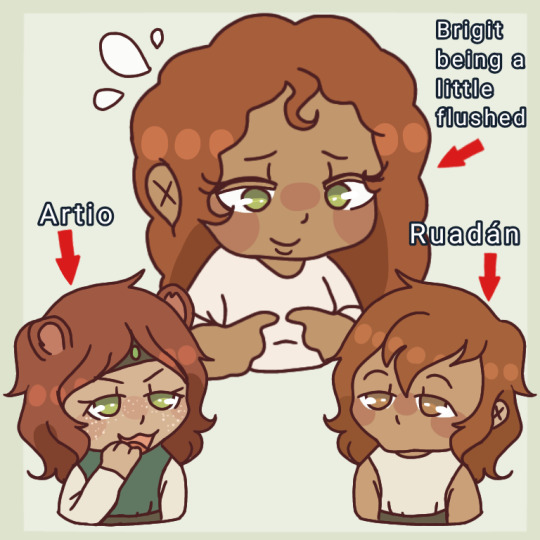
#celtic mythology#haitian vodou#maman brigitte#brigit#brigitte#artio#Ruadán#headcannons#goddess brigid
6 notes
·
View notes
Photo
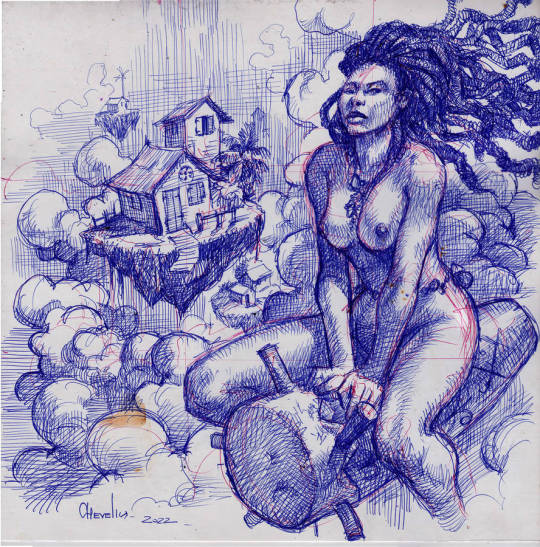
Title: Haitian Goddess 2
Artist: Chevelin Pierre
Drawing process video to Haitian Goddess as well as a fantasy merchant lady and the Haitian goddess Danto.
Also a link to a South Carolinian Mermaid tale and a talk on Gabriella, a little mermaid.
https://aalbc.com/tc/profile/6477-richardmurray/?status=2115&type=status
#rmaalbc #artist#chevelin
51 notes
·
View notes
Text

i choose myself now & that’s powerful
#me#melanin#energy#glow#Mexico#beachday#nature#goddess#love#healing#haitian#culture#life#sundayfunday#enjoylife
66 notes
·
View notes
Text

DC characters - Erzulie
#dc comics#dc vertigo#erzulie#dc characters#house of whispers#loa#haitian vodou#dc#dc black label#fanart#fan art#goddess#dc deities#the sandman universe
56 notes
·
View notes
Text

Just remember ladies that Erzulie Dantor is always watching over us!
🇭🇹🧕🏾🗡
#history#vodou#erzulie dantor#haiti#lwa#womens history#love#lgbt#divine feminine#black girl magic#haitian revolution#goddess#knives#lgbt history#black femininity#black women#slavery#lgbtq#haitian history#girl power#women empowerment#lgbtq history#lesbian#girly things#africa#black history#haitian vodou#femininity#nickys facts
19 notes
·
View notes
Text
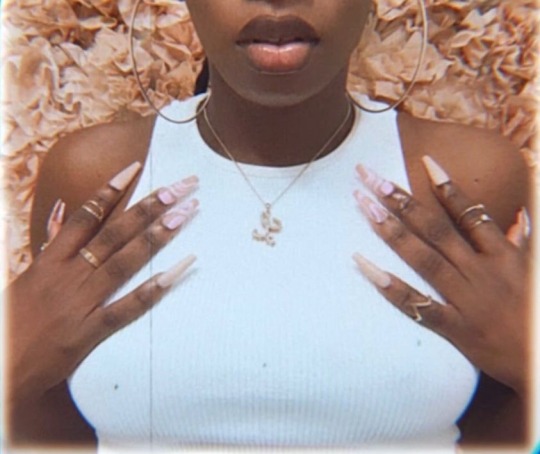

IG: @mustbe.love_
#edits#haitian#mydopelife#black fashion#black tumblr#art#follow#models#black queen#goddess#goldskin#brown skin#locs
15 notes
·
View notes
Link
Ti Malice
Ti Malice is a trickster figure in Haitian folklore. He is cunning and clever, but lazy, and serves as the nemesis and antithesis to the unlucky Uncle Bouki, who is greedy and imbecilic, but hardworking. Ti Malice normally comes out on top of their encounters, with Uncle Bouki getting the short end of the stick. Ti Malice’s tricks vary from slightly malicious to wicked and harmful, so it is best to be wary.
Keep Reading
#Ti Malice#Uncle Bouki#Myths#Mythos#Mythos Articles#Trickster gods of African Myth#African Gods#Gods and Goddesses#Trickster Gods#Haiti#Haitian Myths#Haitian Gods#Tricksters#Folklore#Mythology
3 notes
·
View notes
Text

Today's topic is relatively serious, witches! Let's unravel the enchanting tapestry of Wicca, witchcraft, and paganism, shall we? While these terms are often used interchangeably, they each have their own unique traditions, beliefs, and practices. Here's a glimpse into their similarities and differences:
Wicca: Wicca is a modern pagan religion that was developed in the mid-20th century by figures such as Gerald Gardner and Doreen Valiente. It is centered around the worship of nature and the reverence of the divine, often symbolized by a god and goddess representing the masculine and feminine energies of the universe. Wiccans celebrate seasonal festivals, known as Sabbats, and honor the cycles of the moon in their rituals. Wicca emphasizes personal responsibility, ethical behavior, and the practice of magic as a tool for spiritual growth and transformation.
Witchcraft: Witchcraft, on the other hand, is a practice rather than a religion. It encompasses a wide range of magical traditions, beliefs, and practices that are rooted in ancient folk magic, shamanism, and occultism. Witches may or may not adhere to a specific religious belief system, and their practices can vary greatly depending on individual preferences and cultural influences. Witchcraft is often associated with spellcasting, herbalism, divination, and connecting with the energies of the natural world.
Paganism: Paganism is a broad umbrella term that encompasses a diverse array of spiritual traditions and practices that are rooted in pre-Christian, indigenous, or nature-based religions. Paganism honors the sacredness of the earth and the divine energies that permeate all living things. It includes traditions such as Druidry, Heathenry, Hellenism, and various forms of polytheism, animism, and pantheism. Pagans celebrate seasonal festivals, honor ancestral spirits, and cultivate a deep connection with the natural world.
While Wicca, witchcraft, and paganism share some common themes, such as reverence for nature and the practice of magic, they are distinct paths with their own beliefs, practices, and communities. Some practitioners may identify with one or more of these paths, while others may follow their own unique spiritual journey. Whatever path you choose, embrace the magic within you and follow your intuition as you explore the mysteries of the universe. 🌙✨

In the realm of spiritual practices and religions, some traditions are considered "closed," meaning they are intended for specific cultural or ethnic groups and are not open to outsiders or those who do not belong to those groups. The reasons for a tradition being closed vary and can include cultural preservation, respect for ancestral traditions, and the protection of sacred knowledge. Here are some examples of closed practices or religions and why they are considered as such:
Native American Spirituality: Many Indigenous tribes and nations have spiritual practices that are considered closed to outsiders. These traditions are deeply rooted in specific cultural contexts and are passed down through generations within tribal communities. Outsiders are often discouraged from appropriating or practicing these traditions out of respect for Indigenous sovereignty and the protection of sacred ceremonies and knowledge.
Vodou (Voodoo): Vodou is a syncretic religion that originated in Haiti and West Africa, blending elements of African spiritual traditions with Catholicism. It is considered a closed religion because it is deeply intertwined with Haitian culture and history and is traditionally practiced within specific communities. Outsiders are generally not encouraged to practice Vodou without proper initiation and training, as it involves working with powerful spirits and deities.
Shinto: Shinto is the indigenous religion of Japan and is deeply rooted in Japanese culture and history. It involves the worship of kami (spirits or deities) and the practice of rituals at shrines and sacred sites. While Shinto is open to participation by anyone, certain aspects of Shinto practice, such as the inner workings of Shinto priesthood and some shrine rituals, are considered closed to outsiders.
Certain forms of Witchcraft: Some forms of witchcraft, particularly those rooted in specific cultural traditions or lineages, may be considered closed practices. For example, some forms of African diasporic witchcraft, such as Hoodoo and Santeria, are traditionally practiced within specific cultural communities and are not open to outsiders without proper training and initiation.
It's important to approach spiritual practices with respect, humility, and sensitivity to cultural and historical contexts. While it's natural to be curious about different traditions, it's essential to recognize and honor the boundaries of closed practices and to seek guidance and permission from practitioners within those traditions before engaging with them.

In closed practices, certain aspects are not open for use or appropriation by individuals who do not belong to the specific cultural or ethnic groups associated with those practices. These aspects often include:
Sacred Rituals and Ceremonies: Closed practices typically involve sacred rituals, ceremonies, and rites that are deeply rooted in specific cultural or ancestral traditions. These rituals may involve working with powerful spirits, deities, or ancestors and are considered sacred and highly respected within the community. Outsiders are generally not permitted to participate in or appropriate these rituals without proper initiation and training.
Traditional Knowledge and Wisdom: Closed practices often involve the transmission of traditional knowledge, wisdom, and teachings that are passed down through generations within cultural communities. This knowledge may include spiritual beliefs, practices, herbal remedies, and magical techniques that are specific to the cultural context and are not meant to be shared with outsiders without permission.
Sacred Objects and Symbols: Certain sacred objects, symbols, and artifacts are considered sacred within closed practices and are used in rituals and ceremonies as vessels for spiritual energy or as tools for communication with spiritual forces. These objects may include ritual implements, sacred plants, and religious symbols that hold deep significance within the cultural context. Outsiders are generally not permitted to use or appropriate these objects without proper understanding and respect for their meaning and purpose.
Initiation and Training: In many closed practices, initiation into the tradition and proper training are essential prerequisites for engaging in spiritual practices and rituals. Initiation ceremonies often involve a formal process of acceptance into the community and may include teachings, rituals, and oaths of allegiance. Proper training under the guidance of experienced practitioners is necessary to ensure the safe and respectful practice of closed traditions.
Cultural Appropriation: Outsiders are cautioned against appropriating elements of closed practices without proper understanding, respect, and authorization from the cultural community. Cultural appropriation involves the unauthorized use, adoption, or exploitation of cultural elements by individuals who do not belong to that culture, often resulting in the distortion, commodification, or trivialization of sacred traditions and practices.
It's important to approach closed practices with humility, respect, and a willingness to learn from and honor the cultural context from which they arise. Seek guidance from experienced practitioners within the community and always ask permission before engaging with sacred rituals, objects, or knowledge.
I really recommend doing your own research of what is and isn't sacred or closed practices for the sake of your own reputation as well as for the sake of yourself. There are many good collections of information available. This website provides alternatives as well. This website also highlights the new interests in witchcraft recently and notes the closed and sacred practices and why.
#magickkate#reference#witchblr#witches#kitchen witch#sigils#witch#witchcraft#queue the magick#green witch#witchy#beginner witch#college witch#baby witch tips#baby witch#cottage witch#quarantine witch#college witch tips#witch aesthetic#witchcraft 101#witchcraft community#witch community#witches of tumblr#witch tips#witchtok#witchy vibes#witchy shit#witchyvibes
29 notes
·
View notes
Text
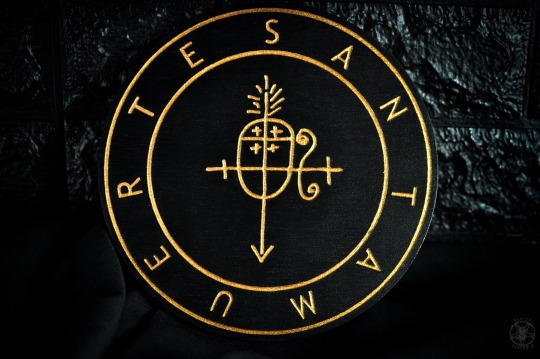

Image ID: First image: a "veve" of La Santa Muerte. Second image The same "veve" but with the "no" sign superimposed. End Image ID
If you involved in El Culto a la Santa Muerte in any sort of way, chances are that you may have seen this "sigil" online and being sold on places like etsy
It is fake and cultural appropriation. Do not use
The "sigil" you see here is supposed to be a veve, a religious symbol used in Haitian Vodou to represent a specific Lwa (at least according to Wikipedia). Santa Muerte is not a Lwa; she is a Mexican Catholic folk saint. She does not have veve
Now while there is a theory that an ATR may have influenced the creation of El Culto a la Santa Muerte, the ATR is question is Santería, not Haitian Vodou. To my knowledge, Santería does not use veves
Further digging into the origins of this fake veve revealed that it was allegedly made up in 2012 by someone attempting to demonize both El Culto and Haitian Vodou
Unfortunately, as El Culto grows in popularity and more and more people ignore pleas and warnings from traditional Mexican Muerteros to not separate Santa Muerte from Mexican culture and Catholicism, this sort of thing will occur more often
It is important that followers and allies, particularly white followers and allies, do their research and prevent this sort of thing from spreading. If you are not Mexican, this includes doing research on Mexican culture and Brujería. This is not permission to appropriate Mexican culture or Brujería. If you are not Catholic, research on Catholicism. I would also recommend doing research on Aztec and Maya Mythology, Santería, and El Culto al San Pascualito Rey as these are all believed to have directly influenced El Culto a la Santa Muerte. Once again, this not permission to appropriate closed practices
Also important is to listen to traditional Mexican Muerteros. Traditional Mexican Muerteros have stated countless times that El Culto a la Santa Muerte cannot be divorced from Mexican culture or Catholicism and should not be combined with other religions (And please do not try to use Indigenous Mexicans syncretizing the veneration of Santa Muerte with the worship of Mictecacihuatl or other Indigenous Mexican goddesses as a counter example. That is not the same thing).
tl;dr: This "veve" is culturally appropriative bullshit and should not be used by followers or devotees of la Santa Muerte
24 notes
·
View notes
Text



My ver of what I think alastor looked like when human (and some ppl he knew in life) alastor’s cane talks to him so I have a hc that, that’s the Remittence of his best friends soul/ the first soul he ever got. P.s the reasons alastors mom is based off an African boar is because I based her entire form off Erzulie who is the Haitian voodoo/creole voodoo goddess of love and health. The goddesses favorite offering are pigs so I chose a wild swine for her. I also put her in a traditional Quadrille/Karabela dress.
I also drew alastors different outfits (don’t b weird, I only wanted to explore his less human design☠️) I drew some symbols because I believe he’d carve em. Each actually have a meaning bc I did a ton of research making sure I was using em correctly😭
#art#character design#hazbin hotel#alastor#human alastor#voodoo symbols#sorry for the rant#don’t be weird#aroace
22 notes
·
View notes
Text
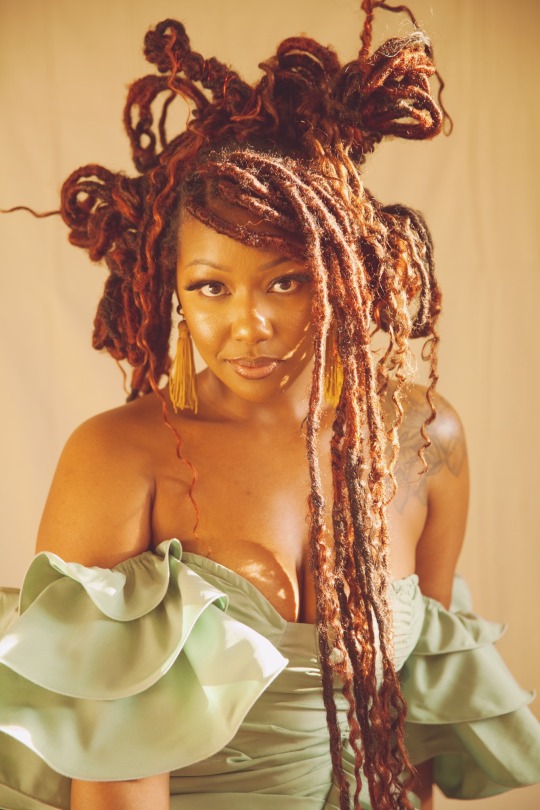
LORD, KEEP ME DIFFERENT
#me#blessed#goodvibes#positive#energy#love#goddess#blackgirlmagic#fauxlocs#peace#innerpeace#healing#protectivestyles#shineyourlight#29#birthdate#glow#melanin#haitian#culture#art
47 notes
·
View notes
Note
Hello, I saw that you had awesome recs for bi4bi books! I rarely have found bi4bi books in genres other than contemporary so I was hoping you could help me with that? Could you please recommend bi4bi (sapphic) books in fantasy, horror, mystery and basically any genre other than contemporary
heads up, these lists will include poly pairings with at least two female characters, pansexual / queer / unlabled multi-gender-attracted identities, and F/NB pairings
bi4bi WLW Fantasy
The Apocalypse of Elena Mendoza by Shaun David Hutchinson: Cuban-American bisexual female x white bisexual female
Payback's a Witch by Lana Harper: bisexual female x Russian-American bisexual female
The Lost Girls by Sonia Hartl: bisexual female x bisexual female
The Goddess of Nothing At All by Cat Rector: Norse bisexual female x pansexual genderfluid LI
Thornfruit by Felicia Davin: starts with lesbian female x bisexual female, but ends with an FFNB poly triad with a bisexual genderfluid MC
A Lake of Feathers and Moonbeams by Dax Murray: polyamorous bisexual female x queer non-binary MC x Asian bisexual female
Vicious Devotion by Aveda Vice: queer female x queer female x queer male x queer male in a polyamorous quartet
The Sea Witch by Katee Robert: half-Vietnamese polyamorous bisexual sub female x older fat black mga Domme female LI x (sub?) male LI in a polyamorous triad
bi4bi WLW Historical
The Companion by E. E. Ottoman: polyamorous bisexual transgender female x bisexual transgender female x transgender male
Her Countess to Cherish by Jane Walsh: pregnant bisexual female x mga bigender LI
Mademoiselle Revolution by Zoe Sivak: biracial Haitian bisexual female x French bisexual female (possible) LI; French male (possible) LI
Windfall by Shawna Barnett: bisexual female MC x bisexual female MC x asexual male LI x male LI (love square, but the bi!F MCs do also romance each other)
Scandalous Passions by Nicola Davidson: Domme bisexual female x sub questioning bisexual female x sub straight male with a stutter in a polyamorous triad
bi4bi WLW Horror
Wilder Girls by Rory Power: mga female x queer female
A Dowry of Blood by S. T. Gibson: polyamorous bisexual female x bisexual female with mood swings and depression x bisexual male
bi4bi WLW Mystery
Missing, Presumed Dead by Emma Berquist: bisexual female x bisexual female
All the Things We Do in the Dark by Saundra Mitchell: white pansexual female with PTSD x Korean-American queer mga female
The Girls I've Been by Tess Sharpe: bisexual female x mga female
Bury the Lede by Gaby Dunn: bisexual female x bisexual female, black lesbian female
The Night She Disappeared by Lisa Jewell: mga female x straight male (possible) LI; bisexual female (possible) LI
The Drowning Summer by Christine Lynn Herman: bisexual female x bisexual female
bi4bi WLW Sci-Fi
Curved Horizon by Taylor Brooke: bisexual female x demisexual panromantic female
City of Shattered Light by Claire Winn: chronically ill bisexual female x Japanese/ Portugese bisexual female
Victories Greater Than Death by Charlie Jane Anders: white pansexual female x black Brazilian bisexual trans-nonbinary femme
Honor Among Thieves by Rachel Caine: black bisexual female x Brazilian bisexual female x bisexual male in a polyamorous triad
full notes on representation and publishing info at qbdatabase.com
64 notes
·
View notes
Note
Can you guys re-imagine the culture(s) of the Chasind?
Hey anon!
That's a fantastic suggestion! Our campaigns have been taking place mostly in northern Thedas, so we didn't even have Chasind people/Kocari Wilds on the map yet, but you're so right. I didn't know much about the Chasind before reading up on the Bioware Wiki (BW for short) and.....yooof.
We'll definitely do a more thought-out and 'official' entry, but since a lot of our re-imaginings move at a snail's pace, I'll share some of our immediate thoughts after discussing this:
Geography:
It's giving BIG bayou vibes, and we're taking that and running with it, nodding at inspiration of early Black-American culture that emerges in the southern USA and the greater Caribbean Islands. Visuals of the Florida Everglades and Bayou Bartholomew in Arkansas, with a majority of the villages being built on stilts or the massive trees that are similar to the ones seen in the Frostback Basin (Jaws of Hakkon DLC specifically). There are settlements on more solid land, but most of the population and the 'civilians' live inside the swamp, as the tricky terrain doubles as protection and security.
The People:
Based off the BW, we're seeing patterns of love for nature and the seasons, and the mention of "animalistic goddesses" is making us think....DND druid style. (we took one look at the "barbaric" descriptions and tossed it all out, thank you)
Animal companionship is common among Chasind, whether they are "working animals" that warriors and hunters may keep that help them in their tasks, or companions for your local shopkeep or fisherman. Big or small, smart or.....lovable...animals are all around and children may even receive their companion at very young ages, growing up with their animal friend.
Some more magically gifted Chasind can even transform and take an animal form.
Chasind are bonded by clan systems, not blood or background. Meaning that if someone needs help in the village, people will band together to support that person. Once you settle in the swamp, you're family.
The Chasind have a large population of people with darker skin tones, but people with lighter skin tones are not uncommon either.
The Culture
Being situated on top of it, of course, water is EVERYTHING.
Navigating the bayou is no easy feat, and children are taught from a young age through legends, stories, and all sorts of oral histories how dangerous the water can be.
There are definitely some pretty cool eldritch beings living out in the swamp, and there are definitely stories about them.
Fishing culture is HUGE. Fishermen are taught a very sophisticated type of navigation and tracking, most commonly using the stars as a guide to chart the swamp, because the landscape can be incredibly difficult to navigate, especially after dark.
According to the BW, the Chasind have "developed their own language, but are capable of speaking the King's tongue", so we took this as they've managed to blend an older language like the one spoken by their Alamaari ancestors and merged it with the King's tongue (not unlike real-world languages, such as Haitian Creole, Jamaican Patois, or Michif)
People also traverse the swamp on stilts to keep out of the water and out of the way of other water predators. Whether they are walking across the village or going out to the fishing holes to get a daily catch.
Please feel free to add your own comments or thoughts on this re-imagine! This entire project is a joint effort, and having perspectives from other backgrounds is always helpful to make it more inclusive.
#answer#idea sharing#reimagining thedas#thorgans guide to thedas#world of thedas#dragon age table top#dragon age ttrpg#chasind
14 notes
·
View notes
Text

Rainbow Spirits
Through many cultures the rainbow is something magical and sacred. These are some of the deities and spirits associated with the rainbow
Manzat: Mesopotamian and Elamite Goddess who was the personification of the rainbow
Iris: Greek Goddess who personifies the rainbow, or in other myths, the rainbow is the path she travels as the delivers messages from the Gods to the human realm
Rainbow Serpent: Aboriginal Australian Creator god who also controlled the rain
Hong: Chinese two-headed Dragon who represents the rainbow
Ix Chel: Mesoamerican Goddess of rain, birth, and healing. Chel means rainbow.
Anuenue: Hawaiian messenger Goddess to her brothers, Tane and Kanaloa. She is the Rainbow Maiden.
Oxumare: Yoruba Orisha who is the personification of the rainbow.
Ayida-Weddo: Haitian Vodou Loa who is the personification of the rainbow
Dan: West African Vodun spirit who is represented as a rainbow serpent. Dan is the androgynous son of Mawu, the Divine Creator, and acts as a mediator between the spirits and the living.
Uenuku and Kahukura: Māori atua's and prominent ancestors, both of which are personifications of the rainbow, and usually represent omens.
Cuchavira: Meaning "shining air", she is the personification of the rainbow and protectress of working women and the ill for the Muisca, the indigenous people of the highlands in the Andes.
Amitolane: Rainbow spirit from the mythology of the Zuni, a Native American tribe.
Prende: Albanian Goddess of the dawn, love, beauty, fertility and health. Her belt was said to be the rainbow.
Indra: Hindu God who is the King of the devas and Svarga. He is a God of the sky, lightning, weather, thunder, storm, rain, and war. In Sanskit the rainbow is called the "indradhanus" or the Bow of Indra.
Rama: Hindu hero-king who was the seventh avatar of the God Vishny in the Vaisnava tradition. A Bengali word for rainbow is "rongdhonu", meaning Rama's Bow
Rainbow Prince: French fairytale prince who can only speak when there is a rainbow
Christian God: After the devastating flood that killed all life except for fish and the animals and people on Noah's Ark, God made a promise to never again destroy all life in this way. He gave Earth the rainbow as a symbol of this covenant.
Leprechaun: being from Irish myth that is sometimes classed as one of the Aos Sí. The leprechaun was thought to guard the pot of gold at the end of the rainbow.
Unicorn: A new link between the mythical unicorn and rainbows has been forged, where these have become almost inseparable. It is unsure where this first started. Unicorns symbolize purity, blessing, healing, and freedom.
[Part of a Rainbowmancy series, masterpost here]
#rainbowmancy#rainbow magic#rainbow witch#deity#rainbow#magic#spirits#unicorn magic#witch#witchcraft#witchblr#paganblr#symbolism#mine#personal
11 notes
·
View notes